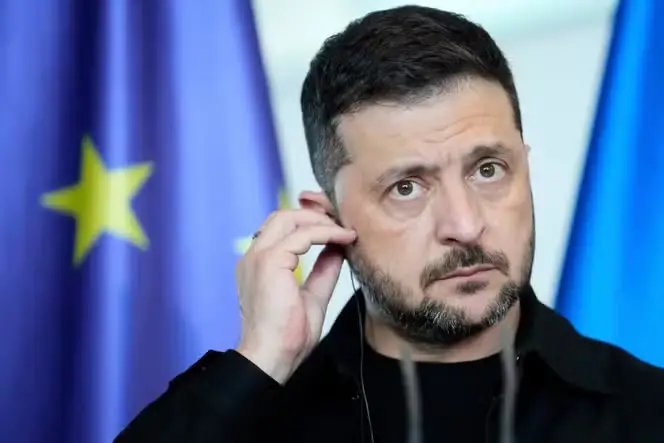High-stakes meeting promises to reshape the trajectory of one of the world’s most consequential conflicts
August 18, 2025
A carefully orchestrated series of public statements and diplomatic maneuvers has set the stage for what many are calling a pivotal moment in the ongoing Russia-Ukraine conflict. As world leaders converge in Washington, the delicate balance of international diplomacy hangs in the balance, with potential ramifications that could echo across global politics for years to come.
The intricate web of relationships between key players has become increasingly complex, with each statement and gesture scrutinized for hidden meanings and strategic implications. What began as seemingly routine diplomatic correspondence has evolved into a high-stakes game of political chess, where every move carries the weight of nations and the hopes of millions caught in the crossfire of an extended conflict.
The Genesis of Current Tensions
The roots of the current diplomatic standoff trace back to a late-night social media post that has reverberated through international corridors of power. On Friday, August 15, President Trump engaged in what sources describe as crucial discussions with Russian leader Vladimir Putin during a surprise meeting in Alaska. The choice of location—neutral territory that has historically served as a bridge between East and West—was itself laden with symbolic significance.
The Alaska meeting, shrouded in the kind of secrecy that has become characteristic of high-level diplomatic encounters, reportedly focused on establishing preliminary frameworks for potential conflict resolution. While no concrete agreements emerged from the discussions, Trump’s subsequent public statements suggested that meaningful dialogue had taken place. His assertion that “progress” had been made toward ending the war carried particular weight, given his administration’s complex relationship with both Russia and Ukraine.
The absence of Ukrainian President Volodymyr Zelenskyy from these initial discussions has become a point of considerable international commentary. Diplomatic observers note that such exclusion—whether intentional or circumstantial—often signals shifting power dynamics in conflict resolution efforts. The optics of major powers discussing the fate of Ukraine without Ukrainian representation has raised questions about the nature of sovereignty and self-determination in modern international relations.
Trump’s Strategic Communications
The former and current president’s approach to international diplomacy has consistently relied on public declarations that blur the lines between negotiation tactics and genuine policy positions. His Truth Social post, published in the early hours following the Alaska meeting, presented what he characterized as clear pathways for Ukraine to end its prolonged conflict with Russia.
“President Zelenskyy of Ukraine can end the war with Russia almost immediately, if he wants to, or he can continue to fight,” Trump declared, framing the conflict’s continuation as fundamentally a matter of Ukrainian choice rather than Russian aggression. This characterization represents a significant departure from the broader international consensus that has viewed Russia as the primary aggressor in the conflict.
The post’s reference to historical precedents—specifically mentioning Crimea’s annexation and Ukraine’s NATO aspirations—reveals the complexity of Trump’s strategic thinking. By invoking the 2014 Crimean crisis and describing it as territory “given” rather than “taken,” Trump’s language suggests a willingness to accept territorial changes that much of the international community has refused to recognize as legitimate.
The timing of this communication, released just hours before Zelenskyy’s arrival in Washington, appeared designed to establish negotiating parameters before face-to-face discussions could begin. This approach—conducting diplomacy through public statements rather than private channels—has become a hallmark of Trump’s international engagement strategy.
Historical Context and Territorial Disputes
Understanding the current diplomatic tensions requires examining the broader historical context of Russian-Ukrainian relations and the role of international guarantees in post-Cold War Europe. The reference to events “12 years ago” in Trump’s post points to the 2014 Crimean annexation, a watershed moment that fundamentally altered the security architecture of Eastern Europe.
The annexation of Crimea represented the first major territorial change in Europe since World War II, breaking decades of post-war stability and challenging the principles underlying the European security order. Russia’s justification for the action—citing historical ties and the protection of ethnic Russians—established precedents that would later influence the 2022 full-scale invasion of Ukraine.
The mention of “security guarantees” in Zelenskyy’s response specifically references the 1994 Budapest Memorandum, in which Ukraine agreed to surrender its nuclear arsenal in exchange for security assurances from the United States, United Kingdom, and Russia. The perceived failure of these guarantees to prevent Russian aggression has become a central element in Ukrainian arguments for stronger international support and eventual NATO membership.
This historical context explains why Ukrainian leadership has been particularly sensitive to suggestions that territorial concessions could form the basis of a sustainable peace agreement. From Zelenskyy’s perspective, previous attempts at accommodation have only encouraged further Russian aggression rather than satisfying Moscow’s territorial ambitions.
Zelenskyy’s Measured Response
The Ukrainian president’s response, delivered through social media shortly after his arrival in Washington, demonstrated the careful balance required of a leader representing a nation under siege while navigating complex international relationships. His statement acknowledged the shared desire for peace while firmly rejecting any framework that would legitimize territorial losses.
“We all share a strong desire to end this war quickly and reliably. And peace must be lasting,” Zelenskyy wrote, establishing common ground with Trump’s stated objectives while subtly challenging the proposed means of achieving them. The emphasis on durability rather than speed reflects Ukrainian concerns that premature peace agreements could simply provide Russia with time to regroup for future aggression.
Zelenskyy’s reference to Ukraine being “forced to give up Crimea and part of our East” in previous negotiations reveals the Ukrainian leadership’s interpretation of past diplomatic efforts as coercive rather than voluntary. This characterization directly contradicts Trump’s suggestion that Ukraine could simply choose to end the conflict through accommodation.
The Ukrainian president’s mention of military successes in the Donetsk and Sumy regions serves multiple diplomatic purposes. It demonstrates Ukraine’s continued capacity for effective resistance, potentially strengthening its negotiating position, while also signaling to international partners that Ukrainian forces remain capable of achieving tactical victories despite prolonged conflict.
International Implications and Alliance Dynamics
The public exchange between Trump and Zelenskyy reflects broader tensions within the international coalition supporting Ukraine. While European allies have generally maintained unified support for Ukrainian sovereignty and territorial integrity, American political dynamics have introduced elements of uncertainty into transatlantic coordination.
Trump’s suggestion that Ukraine could “end the war almost immediately” implicitly challenges the strategic assumptions underlying current Western policy toward the conflict. If Ukraine could indeed achieve peace through accommodation, it raises questions about the wisdom of continued military and financial support for Ukrainian resistance efforts.
European leaders, mentioned in Zelenskyy’s statement as part of his Washington consultations, face their own complex calculations. The prospect of American policy shifts toward greater accommodation with Russia could leave European nations bearing increased responsibility for Ukrainian support while managing their own economic and security concerns.
The NATO dimension of the conflict adds additional layers of complexity to these diplomatic calculations. Ukraine’s eventual membership in the alliance has been a stated goal of Ukrainian policy and a source of significant Russian opposition. Any peace agreement that permanently forecloses NATO membership would represent a major strategic victory for Russia and could have implications for the security of other Eastern European nations.
Military Realities and Negotiating Positions
Behind the diplomatic maneuvering lies the fundamental reality of an ongoing military conflict that has reshaped the security landscape of Eastern Europe. Zelenskyy’s reference to Ukrainian military successes in specific regions reflects the dynamic nature of the battlefield and its impact on diplomatic possibilities.
The mention of Donetsk and Sumy regions highlights the geographical complexity of the conflict, with fighting occurring across multiple fronts and different types of terrain. Ukrainian forces’ ability to achieve tactical victories in these areas demonstrates their continued operational capacity despite resource constraints and international support limitations.
These military realities directly influence the diplomatic positions of all parties involved. Russia’s negotiating stance is inevitably shaped by its forces’ performance on the battlefield, just as Ukrainian willingness to consider various peace proposals depends partly on their military prospects and territorial holdings.
The reference to cities like Kyiv, Odesa, and Kharkiv in Zelenskyy’s statement serves as a reminder of what Ukraine has successfully defended, implicitly arguing that accommodation has limits and that some territorial and sovereignty questions are non-negotiable.
Economic Dimensions and Reconstruction Considerations
While the immediate focus of diplomatic efforts centers on ending active hostilities, the economic dimensions of any potential peace agreement carry enormous implications for all parties involved. Ukraine’s post-conflict reconstruction needs are estimated in the hundreds of billions of dollars, requiring sustained international commitment regardless of how the conflict concludes.
The prospect of American policy changes toward greater accommodation with Russia raises questions about long-term reconstruction funding and the role of various international partners in Ukraine’s recovery. European nations, already bearing significant costs from the conflict through refugee support and military aid, would face increased financial responsibilities if American engagement diminished.
Russian economic considerations also influence diplomatic calculations, as sanctions and international isolation have imposed significant costs on the Russian economy. The potential for sanctions relief as part of a comprehensive peace agreement provides Russia with incentives for diplomatic engagement, though the relationship between economic pressures and territorial ambitions remains complex.
Looking Forward: The Path to Resolution
As diplomatic efforts intensify with high-level meetings in Washington, the fundamental questions underlying the conflict remain unresolved. The tension between achieving rapid conflict termination and ensuring lasting peace reflects deeper disagreements about the nature of international order and the principles governing state sovereignty.
The success or failure of current diplomatic initiatives will likely depend on whether negotiators can identify frameworks that address core security concerns of all parties while maintaining principles of international law and sovereignty. This requires moving beyond public statements and social media exchanges to substantive private negotiations that can explore creative solutions to seemingly intractable problems.
The international community’s response to whatever emerges from these diplomatic efforts will shape not only the future of Ukraine and Russia but also the broader questions of how conflicts are resolved and international order is maintained in an increasingly complex global environment.
The stakes could not be higher, as the outcome of these diplomatic efforts may well determine whether the post-Cold War international system can adapt to new challenges or whether fundamental changes in global power structures are inevitable. For Ukraine, the choice between continued resistance and negotiated settlement remains fraught with implications that extend far beyond its own borders, affecting the future of European security and the principles underlying international relations in the 21st century.

Adrian Hawthorne is a celebrated author and dedicated archivist who finds inspiration in the hidden stories of the past. Educated at Oxford, he now works at the National Archives, where preserving history fuels his evocative writing. Balancing archival precision with creative storytelling, Adrian founded the Hawthorne Institute of Literary Arts to mentor emerging writers and honor the timeless art of narrative.
